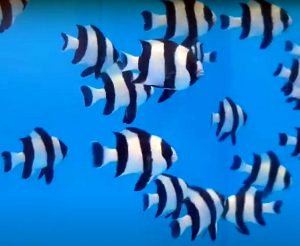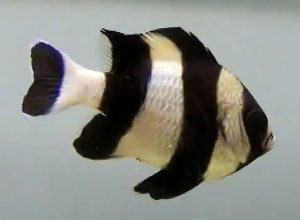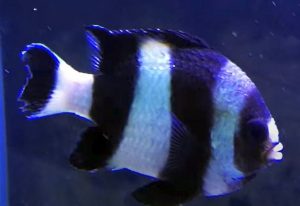Four Striped Damselfish (Dascyllus melanurus) known to tropical fish keeping enthusiasts as Blacktail Dascyllus, Blacktail Damselfish, Humbug Damselfish, or Blacktail Humbug is found in West Pacific waters from the Indo Australian Archipelago and western Caroline Islands including Indonesia, New Guinea, the Philippines, and the northern Great Barrier Reef of Australia.
Four Striped Damselfish are usually found in schools of 25 or more individuals around staghorn Acropora and other isolated coral heads in the shallow lagoons and subtidal reefs of their range in depths from 3 to over 110 feet. Although usually encountered in schools or small harems, both juveniles and adults are often found alone in these same locales.
Dascyllus melanurus is an active species that feed on fish eggs, crustacean larvae, algae, ostracods, amphipods, copepods, small fish, and tunicates during daylight hours and shelters among the coral heads during the night.
Like Three Stripe Damselfish, Domino Damselfish, and most species of clownfish; juvenile Four Stripe Damselfish will often enter into symbiotic relationships with sea anemone, however, as they become adults they usually cease this activity.
The Four Stripe Damselfish has a snow white body with three wide black bars along the flanks separated by three white bands and a smaller black bar at the tail, and a white spot on the dorsal portion of the snout. The pectoral, pelvic, and caudal fins are black; sometimes edged in blue, and the dorsal fin has two black bars with a white bar in the middle.
Easily confused with the Three Stripe Damselfish (Dascyllus aruanus); Dascyllus melanurus has 4 vertical black stripes while Dascyllus aruanus has 3 black stripes running vertically.
Adult Four Striped Damsels can be sexed based on their appearance. Males are usually larger than females, but a safer method of sexing is to observe the genital area. Males are equipped with a tube that ends in a tip, while females have a wider, crate like tube.
In an aquarium environment, juvenile Four Stripe Damselfish do well in groups of five or more individuals, but caution is needed when housing them with damsels of the same or other species.
Four Stripe Damselfish are reef safe and can be housed in either a reef environment or a FOLR aquarium of at least 30 gallon capacity with a sand or finely crushed coral substrate, plenty of mature live rock arranged into territories with crevices, caves, and overhangs for them to hide among, and a lot of swimming space. Ideally, each Striped Damsel should be provided a territory with its own rock cave or coral head.
Due the aggressive behavior of adults, juveniles can be raised in a FOLR community tank with other moderately aggressive species such as basslets, angels, and most clownfish. Mixing damsels with timid species such as cardinalfish, chromis, or batfish should be avoided. Also, avoid housing them with Lionfish, Snappers, Groupers, Triggers, Eels, or any other predatory fish large enough to swallow them.
In a reef aquarium with corals and carpet type anemones, Four Stripe Damselfish will often bond with an anemone in a symbiotic relationship. They generally do not harm invertebrates, corals, or disrupt the decoration in reef setups.
Although Four Stripe Damselfish are frequently bred in an aquarium environment, the fry are extremely difficult to raise.
During breeding, the males perform a mating “dance” bobbing up and down in the water column to entice a female to lay her adhesive eggs in a prepared nest; typically a shell or smooth rock in the substrate near some type of cover. If the female is receptive, she will join in on the bobbing of the male, follow him to the nesting site, and deposit her eggs. The quantity of eggs varies from female to female but is at least 1,000 per session. After the male fertilizes the eggs, he will guard and aerate them until they hatch out, usually in about three days. During this period, the male becomes extremely aggressive and allows no one near the nest.
In their natural habitat, the tiny fry in their larval stage drift with the current as plankton for about three weeks, feeding on zooplankton and phytoplankton before settling to the bottom as a more developed damsel. A single male will often mate with several females.
In the wild, Four Stripe Damselfish feed on algae, fish eggs, crustacean larvae, ostracods, amphipods, copepods, small fish, tunicates, benthic invertebrates, and other zooplankton.
In an aquarium environment with plenty of mature live rock, they will accept a wide range of live, frozen, and freeze dried foods including omnivore flakes, pellets, Spiurlina
, brine shrimp, Mysis shrimp
, finely chopped fish fillets or shrimp, etc. Small portions fed several times throughout the day are recommeded over one or two large portions.
Four Stripe Damselfish (Dascyllus melanurus) are commonly available to tropical fish keeping enthusiasts in local fish shops and from online wholesalers, trans shippers, and retailers at prices varying from $5.00 to $23.00 at a purchase size of 3/4″ to 1-1/2.
Although some newcomers to the tropical fish keeping hobby use Dascyllus melanurus to cycle their systems; using cured live rock is a much better option.
Minimum Tank Size: 55 gallons
Aquarium Type: Reef or FOLR
Care Level: Easy
Temperament: Aggressive
Aquarium Hardiness: Very Hardy
Water Conditions: 72-78°F, dKH 8 to 12 , pH 8.1 – 8.4, sg 1.020-1.025
Max. Size: 3.3″
Color Form: Black, White
Diet: Omnivore
Compatibility: Reef
Origin: West Pacific
Family: Pomacanthidae
Lifespan: 5 years
Aquarist Experience Level: Beginner





